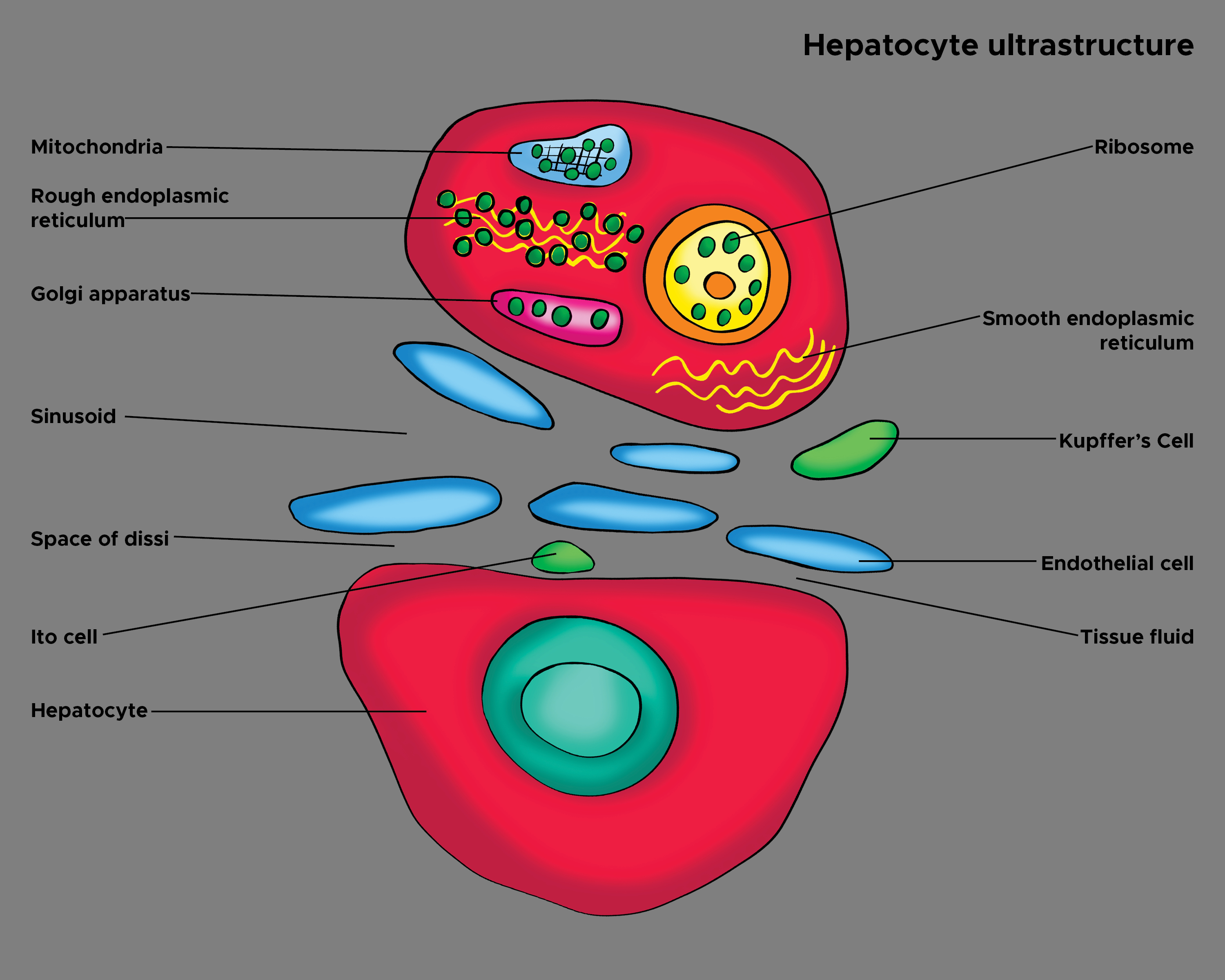[2]
Gomez Perdiguero E,Klapproth K,Schulz C,Busch K,Azzoni E,Crozet L,Garner H,Trouillet C,de Bruijn MF,Geissmann F,Rodewald HR, Tissue-resident macrophages originate from yolk-sac-derived erythro-myeloid progenitors. Nature. 2015 Feb 26
[PubMed PMID: 25470051]
[3]
Yamamoto T,Kaizu C,Kawasaki T,Hasegawa G,Umezu H,Ohashi R,Sakurada J,Jiang S,Shultz L,Naito M, Macrophage colony-stimulating factor is indispensable for repopulation and differentiation of Kupffer cells but not for splenic red pulp macrophages in osteopetrotic (op/op) mice after macrophage depletion. Cell and tissue research. 2008 May
[PubMed PMID: 18335245]
[4]
Li W,He F, Infusion of Kupffer Cells Expanded in {i}Vitro{/i} Ameliorated Liver Fibrosis in a Murine Model of Liver Injury. Cell transplantation. 2021 Jan-Dec
[PubMed PMID: 33784833]
[5]
Role of Kupffer cells in the pathogenesis of liver disease., Kolios G,Valatas V,Kouroumalis E,, World journal of gastroenterology, 2006 Dec 14
[PubMed PMID: 17167827]
[6]
Wisse E,Braet F,Luo D,De Zanger R,Jans D,Crabbé E,Vermoesen A, Structure and function of sinusoidal lining cells in the liver. Toxicologic pathology. 1996 Jan-Feb
[PubMed PMID: 8839287]
[7]
Naito M,Hasegawa G,Ebe Y,Yamamoto T, Differentiation and function of Kupffer cells. Medical electron microscopy : official journal of the Clinical Electron Microscopy Society of Japan. 2004 Mar
[PubMed PMID: 15057601]
[9]
Wisse E, Observations on the fine structure and peroxidase cytochemistry of normal rat liver Kupffer cells. Journal of ultrastructure research. 1974 Mar;
[PubMed PMID: 4363811]
[10]
Campion SN,Tatis-Rios C,Augustine LM,Goedken MJ,van Rooijen N,Cherrington NJ,Manautou JE, Effect of allyl alcohol on hepatic transporter expression: zonal patterns of expression and role of Kupffer cell function. Toxicology and applied pharmacology. 2009 Apr 1
[PubMed PMID: 19371622]
[11]
Nguyen-Lefebvre AT,Horuzsko A, Kupffer Cell Metabolism and Function. Journal of enzymology and metabolism. 2015;
[PubMed PMID: 26937490]
[12]
Hardonk MJ,Dijkhuis FW,Grond J,Koudstaal J,Poppema S, Evidence for a migratory capability of rat Kupffer cells to portal tracts and hepatic lymph nodes. Virchows Archiv. B, Cell pathology including molecular pathology. 1986
[PubMed PMID: 2876547]
[13]
Yamada M,Naito M,Takahashi K, Kupffer cell proliferation and glucan-induced granuloma formation in mice depleted of blood monocytes by strontium-89. Journal of leukocyte biology. 1990 Mar
[PubMed PMID: 2307905]
[14]
Roberts RA,Ganey PE,Ju C,Kamendulis LM,Rusyn I,Klaunig JE, Role of the Kupffer cell in mediating hepatic toxicity and carcinogenesis. Toxicological sciences : an official journal of the Society of Toxicology. 2007 Mar;
[PubMed PMID: 17122412]
[15]
Elchaninov AV,Fatkhudinov TK,Vishnyakova PA,Lokhonina AV,Sukhikh GT, Phenotypical and Functional Polymorphism of Liver Resident Macrophages. Cells. 2019 Sep 5
[PubMed PMID: 31491903]
[16]
Fujita H,Kawamata S,Yamashita K, Electron microscopic studies on multinucleate foreign body giant cells derived from Kupffer cells in mice given Indian ink intravenously. Virchows Archiv. B, Cell pathology including molecular pathology. 1983;
[PubMed PMID: 6132487]
[17]
Gulubova MV, Intercellular adhesion molecule-1 (ICAM-1) expression in the liver of patients with extrahepatic cholestasis. Acta histochemica. 1998 Feb
[PubMed PMID: 9542581]
[18]
van Oosten M,van Amersfoort ES,van Berkel TJ,Kuiper J, Scavenger receptor-like receptors for the binding of lipopolysaccharide and lipoteichoic acid to liver endothelial and Kupffer cells. Journal of endotoxin research. 2001
[PubMed PMID: 11753207]
[19]
Thomas CA,Li Y,Kodama T,Suzuki H,Silverstein SC,El Khoury J, Protection from lethal gram-positive infection by macrophage scavenger receptor-dependent phagocytosis. The Journal of experimental medicine. 2000 Jan 3;
[PubMed PMID: 10620613]
[20]
Luedde T,Schwabe RF, NF-κB in the liver--linking injury, fibrosis and hepatocellular carcinoma. Nature reviews. Gastroenterology & hepatology. 2011 Feb
[PubMed PMID: 21293511]
[21]
Ciesielska A,Matyjek M,Kwiatkowska K, TLR4 and CD14 trafficking and its influence on LPS-induced pro-inflammatory signaling. Cellular and molecular life sciences : CMLS. 2021 Feb;
[PubMed PMID: 33057840]
[22]
Chen W,Zhang J,Fan HN,Zhu JS, Function and therapeutic advances of chemokine and its receptor in nonalcoholic fatty liver disease. Therapeutic advances in gastroenterology. 2018;
[PubMed PMID: 30574191]
Level 3 (low-level) evidence
[23]
Bilzer M,Roggel F,Gerbes AL, Role of Kupffer cells in host defense and liver disease. Liver international : official journal of the International Association for the Study of the Liver. 2006 Dec
[PubMed PMID: 17105582]
[24]
van Oosten M,van de Bilt E,van Berkel TJ,Kuiper J, New scavenger receptor-like receptors for the binding of lipopolysaccharide to liver endothelial and Kupffer cells. Infection and immunity. 1998 Nov
[PubMed PMID: 9784510]
[25]
Hirano K,Kobayashi T,Watanabe T,Yamamoto T,Hasegawa G,Hatakeyama K,Suematsu M,Naito M, Role of heme oxygenase-1 and Kupffer cells in the production of bilirubin in the rat liver. Archives of histology and cytology. 2001 May;
[PubMed PMID: 11436987]

